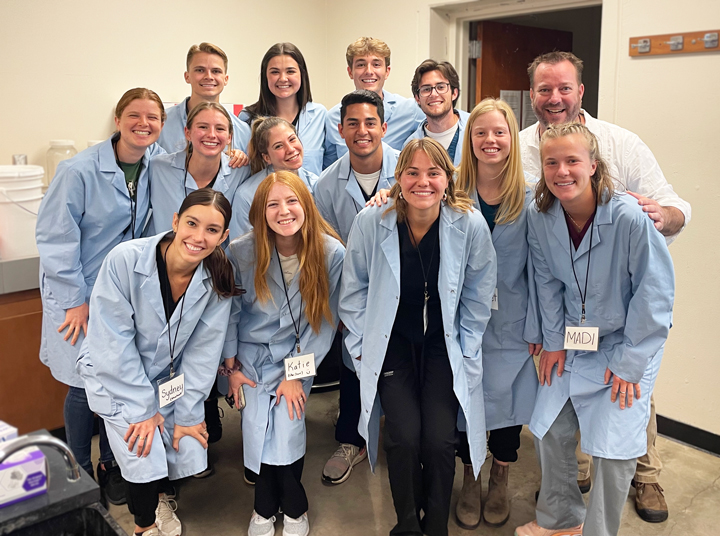Learn by Doing Lab Uses Body Donations to Teach High School Students
June 23, 2022
 Through a rare opportunity to observe the human body in a form they likely will never forget, Central Coast high school students visited Cal Poly’s first Learn by Doing Lab Body Donation program site this spring to study actual, dissected cadavers.
Through a rare opportunity to observe the human body in a form they likely will never forget, Central Coast high school students visited Cal Poly’s first Learn by Doing Lab Body Donation program site this spring to study actual, dissected cadavers.
On Fridays in April and May, a team of 13 Cal Poly students led by full-time biological sciences lecturer Dr. Mike Jones, offered high school visitors an anatomy experience typically reserved for medical school students across university campuses nationwide.
The in-person learning program was initially scheduled to start in spring 2020, but COVID-19 disruptions postponed the inaugural lab until this year.
“Our Cal Poly students are learning how to present STEM information to the community, which helps them integrate their own knowledge of the subject,” Jones said.

Dozens of student visitors from high schools ranging from Paso Robles to Santa Maria visited campus for one-day field trips over the two-month period.
The Learn by Doing Lab program was created thanks to a Cal Poly partnership with the University of California San Francisco (UCSF), which receives cadavers for medical education and research through its Willed Body Program.
Jones runs Cal Poly’s ongoing dissection program which has received UCSF body donations over the years for educational opportunities.
As part of the new lab, he worked with a team of Cal Poly student ambassadors from majors such as biological sciences, public health, nutrition and communication.
Cal Poly students led presentations that engaged high school students in learning activities at five stations that focused on the cardiovascular, digestive, muscular, articular and nervous systems.
Chance Hoellwarth, Cal Poly’s CESAME director, said that the new program is a more advanced model of other types of Learn by Doing labs offered to community fourth through eighth graders.
“The students get to learn some exciting science and see Cal Poly,” Hoellwarth said. “The undergraduates get to try teaching to see if that is something they are interested in, but at the very least it is fun and develops their communication skills.”
The high school guests, mostly juniors and seniors studying advanced biology or anatomy, donned medical gloves to touch body parts like the brain and stomach. Separately, they participated in activities such as a ball toss designed to demonstrate cognitive function.
“Some of the (Cal Poly student) ambassadors want to become STEM teachers and others are planning on attending medical school or to go into public health — and being able to explain how the body operates is essential,” said Menna Street, a Cal Poly public health major and assistant program director, of Seattle, Washington.

Street’s senior research project was to learn by designing and implementing an educational program, and she played a key role in helping shape and run the lab.
This year’s body donations featured a 71-year-old male electrician who died of melanoma, and a 90-year-old female government worker who died of organ failure.
“The experience of seeing a deceased body can be a little shocking,” Street said. “But we are mindful of making sure anyone who is feeling uncomfortable has a chaperone standing by if they need to step out of the room or a moment to adjust.”
Street said that during her participation in the summer dissection process with Jones in preparation for the lab, she initially was a bit uneasy, but gradually she began to dissociate.
“You look at it scientifically and it’s so cool that you forget,” said Street, whose senior project focuses on the Learn by Doing Lab.
On May 20, the final group, Morro Bay High School students, made the rounds, learning how a pig’s femur resembles a person’s and how a small intestine could be stretched to the length of a tennis court if removed from the human body.
“Many of my students have an interest in kinesiology, biology or may want to go on to medical school. This is an amazing, unique opportunity in our backyard. And we’re all proud to bring the college and high school students together.”
Jennifer Frere, Science Department Chair and Teacher, Morro Bay High School
Street said it was helpful for the self-titled Cal Poly student “Anatomy Ambassadors” to review each other’s teaching practices, rotating between their teaching station roles and observing instruction week by week.
“The Anatomy Ambassadors had the academic freedom to adjust the lesson plans week to week, and put their stamp on the program,” Jones said.
Teaching methods included asking the students questions about the function of anatomical systems, offering answer hints if necessary, and the Cal Poly student ambassadors frequently referred to high school students by their names. The Cal Poly ambassadors relied on high school student name tags to capture their attention and urge participation.
“Beyond the lessons, the high school students had the chance to speak with Cal Poly ambassadors about life in college, and how we got here, what we’re studying and interested in,” Street said. “That's a great connection that mentors are good at building.”
Read a first-person Learn by Doing story about a student’s experience with the Cal Poly Cadaver Lab.




